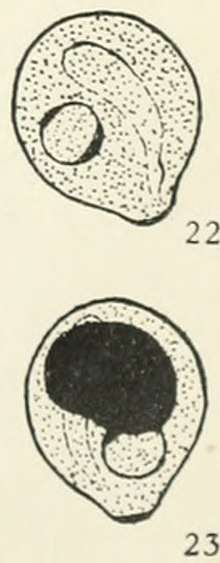Chilomastix mesnili
Chilomastix mesnili is a non-pathogenic[1] member of primate gastrointestinal microflora, commonly associated with but not causing parasitic infections. It is found in about 3.5% of the population in the United States. In addition to humans, Chilomastix is found in chimpanzees, orangutans, monkeys, and pigs. It lives in the cecum and colon. C. mesnili has a similar life style to Giardia lamblia.
| Chilomastix mesnili | |
|---|---|
 | |
| Cysts of Chilomastix mesnili Fig. 22: The cytostome and nucleus clearly visible. Size 8.5 μm × 7.5 μm Fig. 23: The cytostome and nucleus partially obscured by large deeply staining mass of glycogen. Size 8.5 μm×7.5 μm | |
| Scientific classification | |
| Domain: | Eukaryota |
| (unranked): | |
| Phylum: | |
| Class: | Retortamonadea |
| Order: | |
| Family: | |
| Genus: | |
| Species: | C. mesnili |
| Binomial name | |
| Chilomastix mesnili (Wenyon, 1910) | |
Although Chilomastix mesnili is considered non-pathogenic, it often occurs with other parasite infections. C. mesnili may be confused with other pathogenic species during diagnosis. It can create a false positive which would result in unnecessary treatment or a false negative which would withhold necessary treatment.
References
- B. Levecke; P. Dorny; T. Geurden; F. Vercammen; J. Vercruysse (September 2007). "Gastrointestinal protozoa in non-human primates of four zoological gardens in Belgium" (PDF). Veterinary Parasitology. 148 (3–4): 236–246. doi:10.1016/j.vetpar.2007.06.020. hdl:1854/LU-381836. PMID 17656023.
Sources
- Schmidt, G. and Roberts, L. 2005. Foundations of Parasitology (7th ed.), New York: McGraw-Hill
This article is issued from
Wikipedia.
The text is licensed under Creative
Commons - Attribution - Sharealike.
Additional terms may apply for the media files.